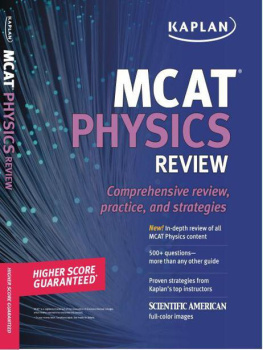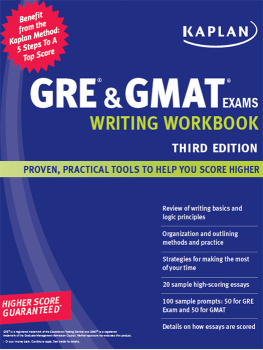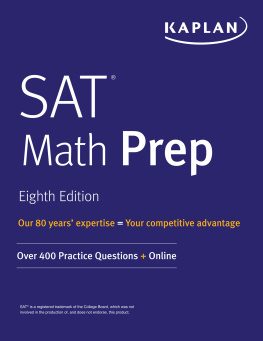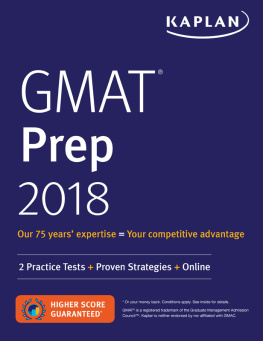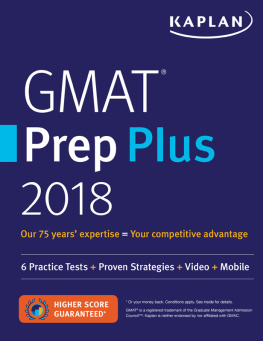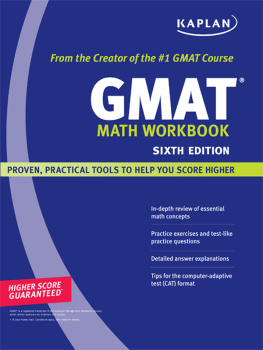Kaplan - Kaplan Portable GMAT
Here you can read online Kaplan - Kaplan Portable GMAT full text of the book (entire story) in english for free. Download pdf and epub, get meaning, cover and reviews about this ebook. year: 2009, publisher: Kaplan Publishing, genre: Children. Description of the work, (preface) as well as reviews are available. Best literature library LitArk.com created for fans of good reading and offers a wide selection of genres:
Romance novel
Science fiction
Adventure
Detective
Science
History
Home and family
Prose
Art
Politics
Computer
Non-fiction
Religion
Business
Children
Humor
Choose a favorite category and find really read worthwhile books. Enjoy immersion in the world of imagination, feel the emotions of the characters or learn something new for yourself, make an fascinating discovery.

Kaplan Portable GMAT: summary, description and annotation
We offer to read an annotation, description, summary or preface (depends on what the author of the book "Kaplan Portable GMAT" wrote himself). If you haven't found the necessary information about the book — write in the comments, we will try to find it.
Kaplan Portable GMAT includes:
- Essential information about the test structure and scoring
- Exclusive score-raising tips and strategies
- Focused practice for each components of the test
- Targeted review of each question type
Kaplan: author's other books
Who wrote Kaplan Portable GMAT? Find out the surname, the name of the author of the book and a list of all author's works by series.
Kaplan Portable GMAT — read online for free the complete book (whole text) full work
Below is the text of the book, divided by pages. System saving the place of the last page read, allows you to conveniently read the book "Kaplan Portable GMAT" online for free, without having to search again every time where you left off. Put a bookmark, and you can go to the page where you finished reading at any time.
Font size:
Interval:
Bookmark:
Portable GMAT
The Staff of Kaplan Test Prep and Admissions

The Graduate Management Admission Test (GMAT) is used by admissions officers to measure your intellectual ability and predict academic success in the first year of a graduate business school program.
An integral part of the admissions process at almost all schools, the GMAT measures verbal, quantitative, and analytical writing skills that are developed over your educational career. It does not test business competence or specific subject knowledge beyond general mathematics and English usage.
Unlike undergraduate grades, which vary in their meaning from institution to institution and from discipline to discipline, GMAT scores use a consistent standard for all test takers. Thus the GMAT can be a useful guide in comparing the credentials of candidates from widely different backgrounds.
Many schools routinely perform studies to gauge the effectiveness of the GMAT and other admission criteria in predicting performance in their program, and use this information to help them interpret the scores applicants present.
Good luck on the exam.
Let's start with the basics: The GMAT is, among other things, an endurance test. It is a computerized test, consisting of 150 minutes of multiple-choice testing, plus two 30-minute analytical essays. Add in the administrative details, plus two 10-minute breaks, and you can count on being in the test center for about four hours.
It's a grueling experience, to say the least. And if you don't approach it with confidence and rigor, you'll quickly lose your composure. That's why it's so important that you take control of the test, just as you take control of the rest of your application process to business school. Here are the basics.
The GMAT begins with the Analytical Writing Assessment (the AWA). You will be required to compose two different essays, typing them each into the computer using a simple word-processing program. You are given 30 minutes for each essay.
One essay is the Analysis of an Issue topic. You'll have to analyze a given issue or opinion and then explain your point of view on the subject. You will be required to cite relevant reasons and/or examples drawn from your own experience, observations, or reading.
The other essay is the Analysis of an Argument topic, where you'll have to analyze the reasoning behind a given argument and then critique that argument. Your own views on the subject are not relevant.
After the essay sections and a 10-minute break, there are two 75-minute multiple-choice sectionsone Quantitative (Math) and one Verbal. The Quantitative section contains 37 questions in two formats: Problem Solving and Data Sufficiency, which are mixed together throughout the section. The Verbal section contains 41 questions in three formats: Reading Comprehension, Sentence Correction, and Critical Reasoning, which are also mixed throughout the section. Within each section, question types appear in random order, so you never know what's coming next.
This is how the sections breakdown:
AWA: 60 minutes, two essay assignments
Analysis of an Issue Topic (30 minutes)
Analysis of an Argument Topic (30 minutes)
Quantitative (Math) Section: 75 minutes, 37 questions
Data Sufficiency questions
Problem Solving questions
Verbal Section: 75 minutes, 41 questions
Reading Comprehension questions
Sentence Correction questions
Critical Reasoning questions
Some important things to note:
After you have completed the second essay, you'll get a 10-minute break. Then, between the two multiple-choice sections, you will get another break.
So-called experimental questions will be scattered throughout the test. They will look just like the other multiple-choice questions, but won't contribute to your score.
We'll talk more about each of the question types in later chapters. For now, note the following: You'll be answering roughly 78 multiple-choice questions in two and a half hours. That's less than two minutes per question, not counting the time it takes to read the passages. Clearly, you'll have to move fast. But you can't let yourself get careless. Taking control of the GMAT means increasing the speed of your work without sacrificing accuracy!
You will receive four scores for the GMAT:
Overall scaled score, from 200-800
Quantitative scaled subscore, from 0-60
Verbal scaled subscore, from 0-60
AWA score, from 1-6. This score is separate from your overall score for quantitative and verbal.
Because the test is graded on a preset curve, the scaled score will correspond to a certain percentile, which will also be given on your score report. A 590 overall score, for instance, corresponds to the 80th percentile, meaning that 80 percent of test takers scored at or below this level. The percentile figure is important because it allows admissions officers at business schools to quickly get a sense of where you fall in the pool of applicants.
About 20 days after your test date, your official score report will be available online. You'll receive an e-mail when yours is ready. Reports will only be mailed to candidates who request that service. The official score report includes your scores for the Analytical Writing Assessment (AWA), Verbal, and Quantitative sections, as well as your total score and percentile ranking.
In the chapters that follow, we'll cover techniques for answering the GMAT questions. But you'll also need to go into the test with a certain attitude and approach. Here are some strategies.
Test takers are given noteboards (booklets of laminated paper) and a black wet-erase pen to work with during the test. Here are the specs, so you know what to expect on test day:
5 sheets, 10 numbered pages
Spiral-bound at top
First page has test administration and chair operation instructions, and is not suitable for scratchwork. Pages 2-10 consist of a gridded work surface.
Black, fine-point, wet-erase pen
You will not be given an eraser, and you are not supposed to reuse the noteboard. Each time you fill up your noteboard during the test, the administrator will replace your used noteboard with a clean one. You can also request a new pen, if necessary. The note-boards cannot be removed from the test room during or after the exam, and you must return them to the administrator when your exam is complete.
Most test takers have not had any difficulties using the note-boards and pens on test day. However, nothing is perfect, so based on all the feedback we've received from test takers, here are two snags that you just can't prepare for and how to tackle them:
Erasable ink you're not supposed to erase: Say you make a mistake during a calculation, or you smudge your work with your hand. The noteboard's surface probably won't lend itself to quick-and-easy erasing (not surprisingly, since you are not meant to reuse it). So what should you do? Just start over.
A problematic pen: Difficulties with pens are not common at all. The test administrators are careful to provide good writing utensils so test takers don't have any extra anxieties. Also, keep in mind that you should recap your pen when you are not using it so that it doesn't dry out. If you do get a pen that's dry from the start, however, just get a new pen.
Font size:
Interval:
Bookmark:
Similar books «Kaplan Portable GMAT»
Look at similar books to Kaplan Portable GMAT. We have selected literature similar in name and meaning in the hope of providing readers with more options to find new, interesting, not yet read works.
Discussion, reviews of the book Kaplan Portable GMAT and just readers' own opinions. Leave your comments, write what you think about the work, its meaning or the main characters. Specify what exactly you liked and what you didn't like, and why you think so.



